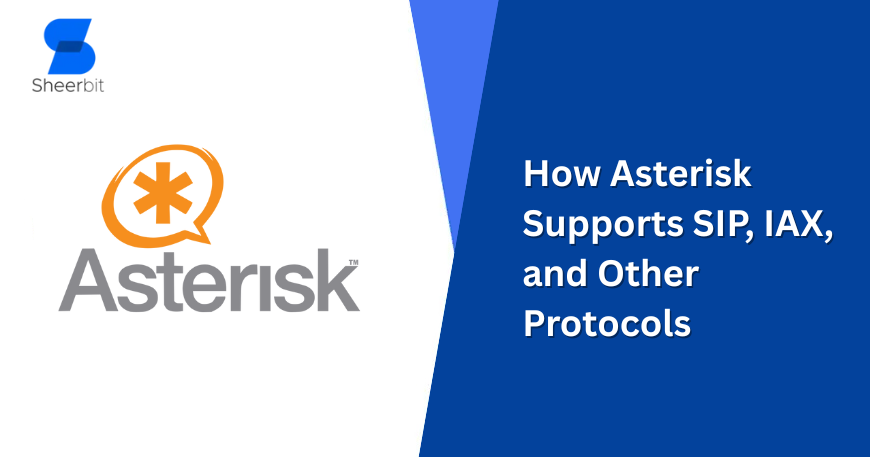It is important for communication systems to be reliable and flexible for day-to-day function in business, whether it’s communication with internal staff or external customers. Asterisk is an open-source PBX system that has become popular due to its compatibility with a variety of VoIP protocols such as that utilizes SIP (Session Initiation Protocol), IAX (Inter-Asterisk eXchange), and other p protocols, including H.323 and MGCP. This protocol flexibility allows businesses to construct their own technology or infrastructure that is reliable, and scalable, and can easily accommodate new VoIP protocols as they become available.
In this article, we will discuss how Asterisk supports the above protocols, and the importance of this flexibility to organizations and individuals. We will also structure this article to discuss the support and use of the various protocols through professional Asterisk development services. Whether you are an enterprise seeking to replace a legacy telecommunications system, or a startup looking to develop an affordable and innovative VoIP infrastructure, a solid understanding of Asterisk support of protocols, can lead to more informed decision-making.
What is Asterisk?
Asterisk is an open-source framework for developing communications applications. Asterisk takes a standard server and, through a sophisticated platform that incorporates a range of applications such as:
- VoIP calling
- Conference bridging
- Call recording
- Interactive voice response (IVR)
- Call routing and queuing – for preventing missed calls and managing different calls
Asterisk gives developers the features of a complete telephony operating system. Asterisk operates on a modular architecture – it can leverage all telephony protocols, telephony hardware and telephony systems, enabling developers to develop support solutions exactly tailored to specific use cases.
The Importance of Protocols in VoIP Communication

VoIP protocols define how voice data is exchanged over the internet. VoIP protocols are responsible for;
- Establishing and managing calls
- Negotiating codecs
- Transmitting an audio stream
- Changing call statuses (Ringing, busy, on-hold, etc.)
Protocols represent challenges and opportunities for consumers. The right protocol will ensure effective routing of calls, quality assurance, scalability and device interoperability possibilities. Asterisk provides native support for the recognized protocols, which has produced highly functional communication systems that also have flexibility.
SIP: The Future of VoIP

What is SIP?
SIP (Session Initiation Protocol) is the most common signalling protocol in telecommunication for voice and video call over IP. SIP delivers a method for developing telecommunication sessions, and establishing, modifying, or terminating those sessions between participants.
How Asterisk supports SIP
Asterisk supports SIP through two different channel drivers.
- chan_sip (support for the chan_sip SIP driver is deprecated) – The original SIP driver and now deprecated
- chan_pjsip – The new modular SIP channel driver that has optimal Positional Performance, Scalability and Security.
The default driver (chan_pjsip) offers;
- Pay as you grow multi-endpoint support
- Better NAT handling
- Flexible Layer Transport Support (UDP, TCP, TLS)
- Some advanced debugging and logging options
SIP Support Features in Asterisk

- Caller id
- Codec negotiation (G.711, G.729, Opus)
- DTMF support
- SIP trunking
- Presence
- Messaging
- Security calling (TLS and SRTP)
Through its SIP integration, Asterisk can function as a soft switch, an IP-PBX, or possibly even a SBC.
If you are looking for an implementation or upgrade of a SIP based communication system, then a professional Asterisk development company who possesses a deep contextual understanding of the deployment and security issues relative to SIP would be an augmentation to your search for innovative telecommunication solutions.
IAX: The Proprietary Protocol of Asterisk
What is IAX?
IAX (Inter-Asterisk eXchange) is a proprietary protocol created only for Asterisk. It was specifically established to ease NAT traversal, reduce overhead and provide trunking of multiple calls over a single link.
Why is IAX useful?
- NAT-Friendly: IAX traverses firewalls better than sip.
- Trunking: trunking of multiple calls over a single stream saves bandwidth.
- Bandwidth usages: Ideal for low-bandwidth connections or satellite connections.
- Compact Headers: Less protocol overhead means faster connections.
How does Asterisk use IAX?
Asterisk offers native IAX support through chan_iax2. Although it is not as widely used as SIP, IAX is perfect for:
- Interop of Asterisk servers
- Creation of remote office extensions
- Disaster Recovery systems
IAX in the Real World
- Patching multiple Asterisk servers between continents.
- Providing remote office voice systems using NAT.
- Creating a distributed call center utilizing high compression codecs.
Whenever you engage Asterisk developers with IAX experience, they can build incredibly efficient VoIP networks without SIP traversal complexities.
Other protocols supported by Asterisk
H.323
Asterisk supports H.323 (to a limited extent) which is a protocol primarily used by traditional VoIP networks. Although it is being phased out, H.323 is still found in legacy systems.
- Supported by chan_h323 or via third party modules such as ooh323
- Is interoperable with older PBXs and video conferencing systems.
MGCP (Media Gateway Control Protocol)
Asterisk can act asThis encourages the use of legacy telecom infrastructure solutions specifically media gateways older versions.
SCCP (Skinny Client Control Protocol)
- Developed by Cisco for use with Cisco IP Phones
- Asterisk supports SCCP via chan_sccp-b (community module)
- This format allows you to use Cisco IP Phones in a mixed environment.
For businesses that still rely heavily on their legacy systems, Asterisk and the right Asterisk development services may have the ability to join the old with the new.
Reasons why Multi-Protocol Support matters:
1. Interoperability
Asterisk has support for numerous protocols so that it is able to work with all types of VoIP hardware and software. Cisco, Avaya, open source SIP clients they all work.
2. Future Proofing
Asterisk supports both modern and legacy protocols allowing you to move to a new telephony infrastructure without having to completely rethink the telephony architecture.
3. Economical Use of Resources
By using highly DC IAX for trunking and SIP for external calls you can cut down on the in resources (bandwidth and licensing) using Asterisk, especially when used by an established Asterisk development company.
4. Flexible Architecture
Are you looking at a distributed architecture using IAX as the trunk or a centralized architecture using SIP as a contact center? Asterisk can be used in either way.
5. Secure but not too Secure!
Asterisk supports encrypted SIP (TLS/SRTP) and controlled security on IAX trunks giving you as much level of security as you want without sacrificing too much performance.
How to Select a Protocol for your Business
SIP – General purpose VoIP, mobile clients, or global communications.
IAX – Server-to-server, low bandwidth, secure trunking.
H.323 – Most commonly used with legacy systems requiring compatibility.
MGCP/SCCP – May be required when working with specific hardware (e.g. Cisco).
As always, the best protocol to choose is custom based on your infrastructure, strategy, and location. A specialist Asterisk development company will work with you to gather your requirements and assist you in creating a protocol strategy.
Common Deployment Use Cases for Asterisk Protocol
1. SIP Trunking to VoIP Providers
SIP trunks are the most common method of connecting to modern VoIP providers such as Twilio and Vonage, or even to local carriers. Asterisk will handle the registration of the equipment to the service provider account, call routing, and even failover!
2. IAX for Redundancy and Waking Up for Failover
These redundant servers will use IAX to keep up-to-date, or even as a disaster recovery imposter. IAX has trunking and can be relatively bandwidth-friendly while still being secured.
3. Hybrid SIP/IAX
Some organizations may use SIP internally but IAX for inter-server communication. Often, organizations will find a comfortable compromise of using IAX for trunking and SIP for communicating with endpoints. This hybrid configuration can help capitalize on the best of both worlds, including performance, security, and call clarity!
4. H.323 or MGCP for Legacy Integration
For large organizations with an invested infrastructure, they may require H.323 to speak to legacy equipment or MGCP to control their media gateways!
Why Work with an Asterisk Development Company?
Customizing and tuning Asterisk for the optimal companion of protocols is more than switching a setting! To successfully implement Asterisk will require;
- Intensive understanding of protocol behaviors
- Teasing out peculiarities of your unique network topology; especially around NAT barriers
- Validation of QoS (quality of service) in real-time
- Advanced troubleshooting skills
By working with an experienced Asterisk development company, you can find the opportunity for;
Custom architecture of a VoIP system
- Security hardening for SIP and IAX
- Codec optimization and load balancing
- Scalable deployment approaches
- 24/7 support & maintenance
Hiring Asterisk Developers for Smarter Communication Solutions
If you are ready to lay the groundwork for;
- Replacing legacy PBX systems side-by-side with Asterisk
- Building a global call center
- Virtual teams that safely integrated into both in-office and at-home functions
- Improving call quality on existing internet circuits
Now is the time to hire Asterisk developers, who can design a system that is based exactly on your needs. Skilled Asterisk developers do more than configure only SIP or IAX! Working with qualified developers will ensure that your new Asterisk system is performing optimally, integrating with CRMs, and javascript protocols or business logic automation through AGI scripts and dial plans.
Final Thoughts
With Asterisk’s support for several protocols (and specifically leveraging SIP/IAX), Asterisk is one of the most customizable communication platforms in the world today. Whether you wish to implement a whole new project or eventually menu-based integrations with existing solutions of your legacy systems, Asterisk gives you the flexibility and power to do so! But using the capability of Asterisk protocols is not an easy operation.
That is why it is important to either partner with an expert Asterisk development company or consider hiring Asterisk developers if your business takes serious performance, compatibility, and security of your communication infrastructure.
Do you want to build a powerful cutting edge VoIP system full of protocols? Work with Sheerbit—an Asterisk development company with expert Asterisk development services. Hire Asterisk developers from Sheerbit and make your communication goals a reality.




